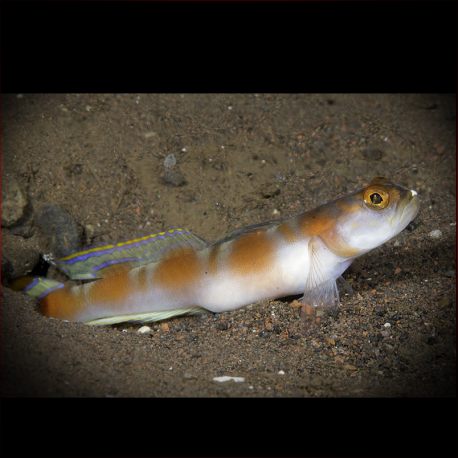More info
Datasheet
| Minimum Tank Size | 100 litres / 26.42 US gallons |
| Maximum Size | 13.0cm / 5.12inches |
| Reef Compatible | Always reef safe |
| Temperament | Aggressive towards similar species |
| Temperature | 22.2°C / 71.96°F - 25.6°C / 78.08°F |
| Specific Gravity | 1.020-1.025 |
| Carbonate Hardness | 8-12 |
| pH | 8.1-8.4 |
General Description
The Flagtail shrimpgoby, scientifically known as Amblyeleotris yanoi, belongs to the Gobiidae family. These fish are native to the Western Pacific, specifically found in areas like the Ryukyu Islands, Bali, and Flores in Indonesia. Generally small in size with a maximum length of around 13.0cm, these fish prefer to dwell close to the bottom of the aquarium.
Aquarium Suitability
Considered suitable for aquariums, the Flagtail shrimpgoby requires specific care due to its unique demands. It is recommended to keep them in a tank larger than 100 liters, well-equipped to meet their needs. Although they can be housed in a smaller tank if necessary, providing a spacious environment is preferred to ensure their well-being.
Demands, Care, and Hardiness
Flagtail shrimpgobies are known to be hardy fish but require frequent feeding, especially when initially introduced into the aquarium. Their diet mainly consists of small crustaceans like krill, mysis, and artemia. These fish prefer a substrate that allows them to burrow, such as sand, coral pieces, and shells. They can be territorial and aggressive towards other similar species, so it's essential to provide them with their own territory to prevent conflicts.
Reef Suitability
Flagtail shrimpgobies are known to be reef-safe, making them suitable additions to reef aquariums. They do not pose a threat to corals or other invertebrates typically found in a reef environment.
Aquarium Setup
When setting up an aquarium for Flagtail shrimpgobies, it is crucial to provide a substrate that enables them to burrow and create holes for shelter. Including rocks in the tank layout can offer additional hiding spots for these fish. Maintaining proper spacing and ensuring secure structures can prevent potential stress, especially if there are other burrowing species present in the tank.
Behaviour
These fish exhibit territorial behavior and may show aggression towards approaching fishes, particularly those of similar species. Providing adequate hiding places and individual territories can help minimize conflicts among tank inhabitants.
Feeding and Diet
Flagtail shrimpgobies have a diet primarily consisting of small crustaceans like krill, mysis, and artemia. Their feeding habits require multiple feedings throughout the day, especially if their natural food source is limited within the aquarium.
Habitat and Distribution
In the wild, Flagtail shrimpgobies are found in the waters of the Western Pacific, specifically in regions such as the Ryukyu Islands, Bali, and Flores in Indonesia. They prefer sandy substrates and rocky areas where they can burrow and establish territories. These fish are often associated with symbiotic relationships with pistol shrimps of the Alpheus genus in their natural habitat.

